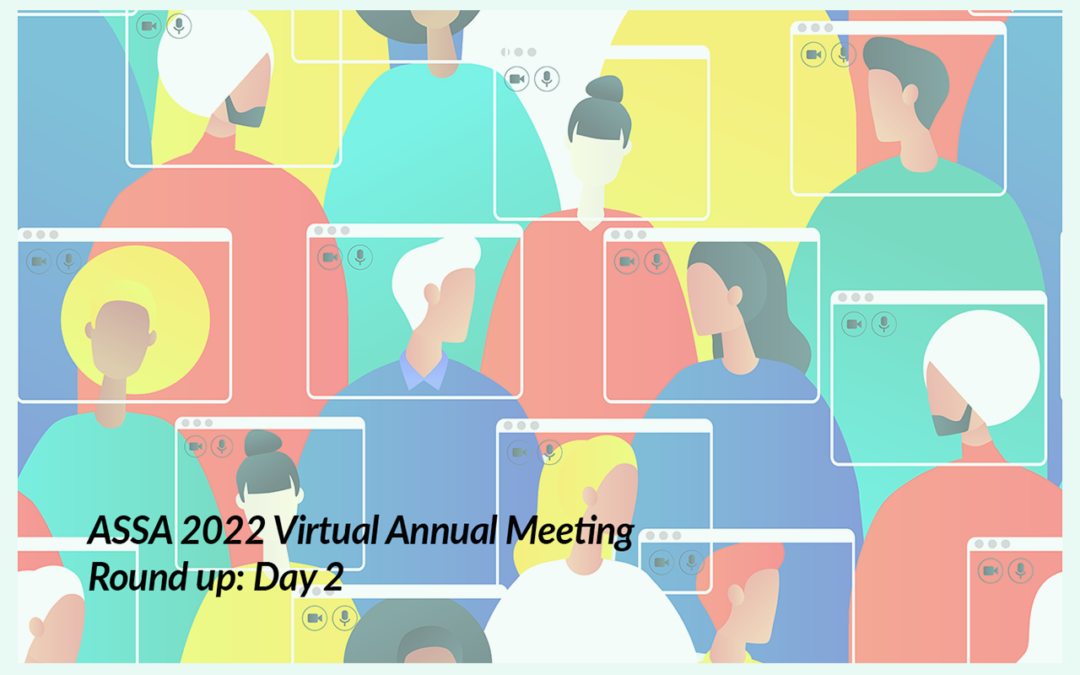ASSA 2022 Round-up: Day 2

Yesterday was the second day of the 3-day annual meeting of the Allied Social Science Associations, which is organized by the American Economic Association. The conference, held virtually again this year due to the ongoing coronavirus pandemic, features hundreds of sessions covering a wide variety of economics and other social science research. This year, Equitable Growth’s grantee network, Steering Committee, and Research Advisory Board and their research are well-represented throughout the program, featured in more than 60 different sessions of the conference.
Below are abstracts from some of the papers and presentations that caught the attention of Equitable Growth staff during the second day of this year’s conference and which relate to the research interests laid out in our current Request for Proposals. We also include links to the sessions in which the papers were presented.
Come back tomorrow morning for more highlights from day three, and click here to review the highlights from day one.
Rachel M.B. Atkins, New York University
Abstract: Literature on opportunity vs. necessity entrepreneurship debates the extent to which these categories should be considered dichotomous constructs. Fairlie and Fossen (2019) design a measure in which unemployed workers who subsequently report being self-employed are classified as necessity entrepreneurs and all others as opportunity entrepreneurs. Their construct operationalizes and builds upon the push-pull theoretical framework which posits that weak labor markets push workers into entrepreneurship while strong demand and abundant supply of financial capital pull workers into entrepreneurship. Given that Black workers face higher levels of unemployment, these theories would predict higher levels of necessity entrepreneurship among this group. However, substantial empirical evidence documents wide Black-White gaps in entrepreneurship. In this study, I examine whether Black-White gaps in entrepreneurship reflect the net effect of racial differences in opportunity vs. necessity entrepreneurship. Using data from the Panel Study of Income Dynamics, I begin with Fairlie and Fossen’s measure of opportunity and necessity entrepreneurship by looking at gaps in self-employment rates among Black and White workers who were previously unemployed or employed by someone else. I then extend their construct. I examine whether length of unemployment increases the likelihood of entering self-employment to assess whether unemployment duration is a better measure of labor demand than the dichotomous unemployment measure. Next, I examine whether the change in local unemployment rates, measured separately for Black and White residents, changes the likelihood of self-employment. Finally, I examine whether earnings from necessity entrepreneurship are comparable to labor market earnings and if earnings differences are the same across racial groups. This analysis will help policymakers and researchers identify the conditions in which rising entrepreneurship among disadvantaged communities produces positive outcomes worth promoting and the conditions under which rising entrepreneurship may be a sign of troubling underlying economic realities for Black workers.
“The Intergenerational Transmission of Employers and the Earnings of Young Workers”
Matthew Steiger, University of Maryland
Abstract: This paper investigates how the earnings of young workers are affected by individuals working for the same firm as their parent. My analysis of U.S. linked survey and administrative data indicates that 7 percent of young workers find their first stable job at a parent’s employer. Using an instrumental variables strategy that exploits exogenous variation in the availability of jobs at the parent’s employer, I estimate that working for a parent’s employer increases initial earnings by 31 percent. The earnings gains are attributable to parents providing access to higher-paying firms. Individuals with higher-earning parents are more likely to work for their parent’s employer and experience larger earnings gains when they do. Thus, the intergenerational transmission of employers increases the intergenerational persistence in earnings. Specifically, the elasticity of initial earnings with respect to parental earnings would be 10 percent lower if no one worked for their parent’s employer.
“Accounting for Racial Wealth Disparities and Reparation Policies in the U.S.”
Illenin Kondo, Federal Reserve Bank of Minneapolis; Teegawende H. Zeida, Brock University; William A. Darity Jr., Duke University; Samuel L. Myers Jr., University of Minnesota
Abstract: While there is a large empirical literature on ongoing racial discrimination and persistent socioeconomic disparities between Black and White households, far fewer contributions evaluate these disparities in the macroeconomics literature. We decompose the determinants of historically persistent and large racial wealth differences in the U.S. since 1950 through the lens of a standard heterogeneous-agents model that allows for group-based privileges or exclusions as wedges. We find that a wedge akin to wealth destruction risk for Black households is essential for generating the persistent and large racial wealth divide. We discuss the implications of these findings for modeling racial wealth disparities and reparations policies.
“Black Women, Black Men, and Occupational Crowding in Non-Standard Arrangements”
Ofronama Biu, New School for Social Research
Abstract: Alternative and contingent employment arrangements offer fewer protections, pay, and benefits. Occupational crowding measures the degree to which a group is over-, under-, or proportionally represented in an occupation, taking educational requirements and the group’s qualifications into account (Hamilton, 2006). Black workers have been systematically crowded into low-wage occupations. This work examines whether Black workers are also overrepresented in nonstandard work. This research expands on the crowding literature by comparing Black women, Black men, and White women to White men, the group with the most labor market advantage (King 1993). My analysis finds Black women and Black men are crowded into contingent work and some of the worst alternative arrangements (e.g., temp agency work) while White men are crowded into more desirable forms of work, such as contract arrangements.
“Changing income risk across the U.S. skill distribution: Evidence from a generalized Kalman filter”
Carter Braxton, University of Wisconsin; Kyle Herkenhoff, University of Minnesota; Jonathan L. Rothbaum, U.S. Census Bureau; Lawrence Schmidt, Massachusetts Institute of Technology
Abstract: For whom has earnings risk changed, and why? To answer these questions, we develop a filtering method that estimates parameters of an income process and recovers persistent and temporary earnings for every individual at every point in time. Our estimation flexibly allows for first and second moments of shocks to depend upon observables, as well as spells of zero earnings (i.e., unemployment) and easily integrates into theoretical models. We apply our filter to a unique linkage of 23.5m SSA-CPS records. We first demonstrate that our earnings-based filter successfully captures observable shocks in the SSA-CPS data, such as job switching and layoffs. We then show that despite a decline in overall earnings risk since the 1980s, persistent earnings risk has risen for both employed and unemployed workers, while temporary earnings risk declined. Furthermore, the size of persistent earnings losses associated with full year unemployment has increased by 50\%. Using geography, education, and occupation information in the SSA-CPS records, we refute hypotheses related to declining employment prospects among routine and low-skill workers, as well as spatial theories related to the decline of the Rust Belt. We show that rising persistent earnings risk is concentrated among high-skill workers and related to technology adoption. Lastly, we find that rising persistent earnings risk while employed (unemployed) leads to welfare losses equivalent to 1.8\% (0.7\%) of lifetime consumption, and larger persistent earnings losses while unemployed lead to a 3.3\% welfare loss.
“The Targeting and Impact of Paycheck Protection Loans to Small Businesses”
Alexander Wickman Bartik, University of Illinois at Urbana-Champaign; Zoe Cullen, Harvard University; Edward Glaeser, Harvard University; Michael Luca, Harvard University; Christopher Stanton, Harvard University
Abstract: What happens when vast public resources are allocated by private actors, whose objectives may be imperfectly aligned with public goals? We study this question in the context of the Paycheck Protection Program, which relied on private banks to rapidly disburse more than $500 billion of aid to small businesses. We present a model suggesting that such delegation is optimal if delay is very costly, the variance of the impact of funds across firms is small, and the correlation between public and private objectives is high. We then use firm-level data to measure heterogeneity in the impact of the PPP and to assess whether banks targeted loans to high-impact firms. Using an instrumental variables approach, we find that PPP loans increased business’s expected survival rates by 9 to 22 percentage points and modestly boosted employment. The potential for heterogeneous treatment effects suggests that targeting may have increased the overall program impact. Yet while banks did target loans to their preexisting customers, treatment effect heterogeneity is sufficiently modest and the correlation between bank loan allocations and public objectives seems sufficiently strong, so that delegation could still have been optimal given the high costs of delay.
Andrew Keefe, Harvard University
Abstract: Despite growing discussion of the unpaid and underpaid labor of incarcerated workers, little is known about how often inmates work, how often they are paid, or precisely how much. We describe the income of incarcerated workers by analyzing data on inmates’ reported earnings from prison and jail surveys. We find that a large share of workers work for no pay. We also find substantial rates of unpaid labor among nonconvicted workers who were incarcerated for pretrial detention. We also find large racial gaps in the wages. The median White incarcerated worker earned, on average, nearly twice as much as his Black counterpart and more than four times as much as his Hispanic counterpart in 2004. Between 1972 and 2004, these gaps seem to have widened more than they did in the general workforce. The findings from our study have four main implications. First, they illustrate just how poorly paid prison work is, for all incarcerated workers. Second, they show elevated racial inequality inside prisons. Third, our findings suggest that social scientists have hitherto mischaracterized the income distribution in the United States. This is because prior studies examining earnings either ignore incarcerated workers, impute their wages based on similar workers outside prison, or assume that they receive nothing for their work. This emphasizes the importance of conceiving of incarcerated workers as members of the formal economy. We suggest that social scientists must take the existence of “incarcerated workers” more seriously.
Jan de Loecker, KU Leuven; Tim Obermeier, Institute for Fiscal Studies; John Van Reenen, London School of Economics
Abstract: Dramatic changes have been documented in the U.S. business landscape in the past few decades, including rising productivity dispersion between firms, higher aggregate mark-ups, the growing dominance of big companies, a fall in labor share and declining business dynamism. In this paper, we address several questions: (i) why should we care about such trends in firm inequality? (ii) have similar trends been occurring in the U.K.? (iii) what are the explanations for these trends? and (iv) what, if any, should be the policy responses? We conclude that most, but not all, of the same empirical trends seen in the United States have occurred in Britain since the mid-1990s, and the likely explanations are related to fundamental forces of technology and globalization rather than country-specific institutions. Over the long run, real wage growth in most countries has tended to follow productivity growth. Since the U.K. had little productivity growth since Global Financial Crisis, it is unsurprising that median and mean real wages had barely recovered to pre-crisis levels by the start of the pandemic. By contrast to the United States, labor shares do not seem to have fallen since 1980 in the U.K., so our key problem is less to do with a decoupling of wages from productivity, and more to do with the severe slowdown in productivity growth since 2007.
“Overeducation as Hiring Policy”
Guillaume Vermeylen, University of Mons; Alexandre Waroquier, University of Mons
Abstract: We provide first evidence regarding the direct effect of a hiring policy oriented through higher (over) education on firm productivity. Moreover, we put light on the moderating role of the working environment of the firm, qualified as high-tech/knowledge intensive. Using a detailed Belgian firm panel data, and computing a measure of overeducation hiring policy robust to sectorial bias, we show that firms that decide to implement a hiring policy of overeducation are found to be more productive than others which follow the hiring standards in terms of educational levels. Concerning the role of the technological environment, we show that high-tech firms may take advantage of additional skills provided by highly educated workers to a bigger extent, the overeducation hiring policy leading to even higher productivity improvements. Unlike much of the earlier literature (still essentially focused on workers’ wages, job satisfaction, and related attitudes and behaviors), our econometric estimates are based on direct measures of productivity. They are also robust to a range of measurement issues, such as time-invariant labor heterogeneity and firm characteristics.
“Older Workers Need Not Apply? Ageist Language in Job Ads and Age Discrimination in Hiring”
Ian Burn, University of Liverpool; Patrick Button, Tulane University; Luis Felipe Munguia Corella, University of California, Irvine; David Neumark, University of California, Irvine
Abstract: We study the relationships between ageist stereotypes—as reflected in the language used in job ads—and age discrimination in hiring, exploiting the text of job ads and differences in callbacks to older and younger job applicants from a resume (correspondence study) field experiment (Neumark, Burn, and Button, 2019). Our analysis uses methods from computational linguistics and machine learning to directly identify, in a field-experiment setting, ageist stereotypes that underlie age discrimination in hiring. The methods we develop provide a framework for applied researchers analyzing textual data, highlighting the usefulness of various computer science techniques for empirical economics research. We find evidence that language related to stereotypes of older workers sometimes predicts discrimination against older workers. For men, our evidence points to age stereotypes about all three categories we consider—health, personality, and skill—predicting age discrimination, and for women, age stereotypes about personality. In general, the evidence is much stronger for men, and our results for men are quite consistent with the industrial psychology literature on age stereotypes.
“The Racial Wealth Gap, 1860-2020”
Ellora Derenoncourt, Princeton University; Chi Hyun Kim, University of Bonn; Moritz Kuhn, University of Bonn; Moritz Schularick, University of Bonn
Abstract: The racial wealth gap is the largest of the economic disparities between Black and White Americans, with a White-to-Black per capita wealth ratio of 6-to-1. It is also among the most persistent. In this paper, we provide a new long-run series on White-to-Black per capita wealth ratios from 1860 to 2020, combining data from the U.S. decennial census, historical state tax records, and a newly harmonized version of the Survey of Consumer Finances (1949–2019). Using these data, we show that wealth convergence was rapid in the 50 years after Emancipation but slowed to a halt by 1950. A simple model of wealth accumulation by racial group reveals that even under equal conditions for wealth accumulation, convergence is a distant scenario, given vastly different starting conditions under slavery. Accounting for post-Emancipation differences in wealth accumulating opportunities indicates that the racial wealth gap is on track to arrive at a “steady state,” close to today’s levels. Our findings shed light on the importance of policies such as reparations, which address the historical origins of today’s persistent gap, as well as policies that reduce inequality and thereby improve the relative wealth position of Black Americans.
“Skilled Scalable Services: The New Urban Bias in Economic Growth”
Fabian Eckert, University of California, San Diego
Abstract: Since 1980, economic growth in the United States has been fastest in its largest cities. We show that a group of skill- and information-intensive service industries are responsible for all of this new urban bias in recent growth. We then propose a simple explanation centered around the interaction of three factors: the disproportionate reliance of these services on information and communication technology, or ICT, the precipitous price decline for ICT capital since 1980, and the preexisting comparative advantage of cities in skilled services. Quantitatively, our mechanism accounts for most of the urban biased growth of the U.S. economy in recent decades.
“Steering Technological Progress”
Anton Korinek, University of Virginia; Joseph E. Stiglitz, Columbia University
Abstract: Rapid progress in new technologies such as Artificial Intelligence has recently led to widespread anxiety about potential job losses. This paper asks how to guide innovative efforts so as to increase labor demand and create better-paying jobs. We develop a theoretical framework to identify the properties that make an innovation desirable from the perspective of workers, including its technological complementarity to labor, the factor share of labor in producing the goods involved, and the relative income of the affected workers. Examples of labor-friendly innovations are intelligent assistants who enhance the productivity of human workers. The paper discusses measures to steer technological progress in a desirable direction for workers, ranging from nudges for entrepreneurs to changes in tax, labor market, and intellectual property policies to direct subsidies and taxes on innovation. In the future, we find that progress should increasingly be steered to provide workers with utility from the nonmonetary aspects of their jobs.



